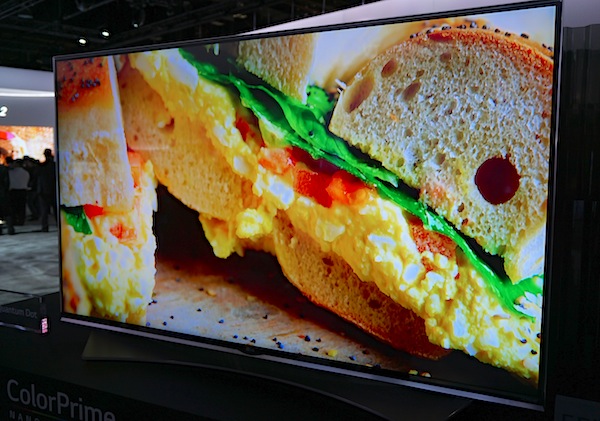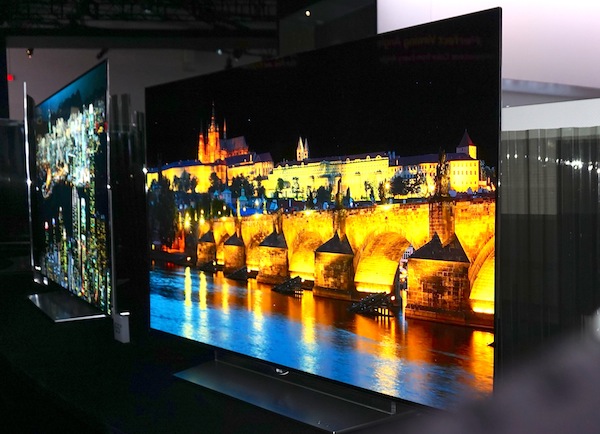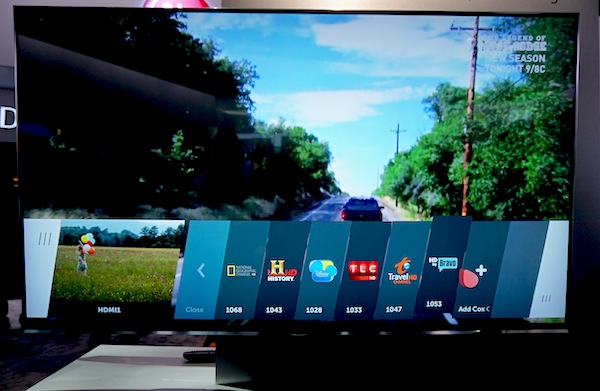LG's UF9550 Nanocrystal TVs Rival OLEDs
If you can't afford its OLEDs, LG's nanocrystal/quantum dot TVs are a good alternative, with the same polished webOS 2.0 smart TV upgrade.

Updated with information about Sling TV support.
LG has become the OLED company, or at least the remaining OLED company, after Samsung more or less dropped out of the game. But look beyond the stunning organic screens, as I did today, and you'll find some great LED-LCDs using the nanocrystal technology that Samsung and Sony are talking up big time.
While LG hasn't provided prices for any of its 2015 TVs yet, you can safely bet that its LCD options will be cheaper than its OLEDs. Like all of LG's new OLEDs, it's high-end nanoctrystal TVs also sport ultra HD resolution, with a new upscaler that makes even so-so HD look sweet, based on a demonstration I saw.
Seeing red, and green
Like all the TV makers out there, LG is struggling with the dirty (not so) secret of LCD TVs: The greens and reds -- two of the three primary colors that make up images -- are flat and poorly saturated. The reason is that inorganic LEDs, unlike OLEDs, just don't put out a wide enough gamut of color to render those hues well. Hence the nanocrsytals, which take in light from first rate blue LEDs and, through the magic of quantum physics, spit out rich, saturated and precisely tuned shades of red and green.
MORE: Hottest TVs for 2015
From the glimpses I've gotten on the overly lit convention floor, with the often weird video clips looping on the TV screens, I can't say if any company's nanocrystal tech works better than another's. But I can say that the LG screens look good, and when at the other side of the room from the OLED screens, looked roughly as good in color (though they can't match OLED's absolute blacks).

Especially important is that the TV supports the new (and actually significant) buzz-abbreviation in television: DCI. This is the way-wider color space that digital movies are recorded in, and displayed in theaters. Today, the movie and TV studios have to dumb down the color to something not much better than what an old tube TV could display, so you don't get the benefit of the extra quality in the original master.
Sign up to get the BEST of Tom's Guide direct to your inbox.
Get instant access to breaking news, the hottest reviews, great deals and helpful tips.
I've seen the difference in a side-by-side (that Samsung showed), and the switch to DCI makes even the best content on the best of TVs look crummy in comparison. There are no sources of DCI color yet, but discs and streams are in the works.
My impressions came mainly from both the new UF9400 and UF9550 lines; but the latter is especially appealing for its super-skinny profile (less than an inch) and a curved metal "Auditorium Stand" meant to bounce audio from the speakers at the bottom of the panel for better sound. The 55- and 65-inch screens have scarcely any bezel (frame) to speak of. A price hasn't been set yet, but this will be a premium model.
LG also has a line of sets that boast a slightly less expanded color gamut by making tweaks to the LED bulbs themselves. It's an improvement, but not as dramatic. Both of these technologies are lumped under the brand name Color Prime Nano Spectrum, which I can imagine confusing a lot of people. Even the TVs that don't have nanocrystals are described as Nano Spectrum.
Slightly smarter TV

All of LG's new sets will be powered by webOS 2.0. It's a mild upgrade, but that's partly a testament to how well designed the original webOS is. The biggest change is startup time, which LG says has been cut down from half a minute or more to less than 10 seconds. (Unfortunately, they didn't let me turn off and boot up a TV at the booth to test it out.)
MORE: Sony Android TV Hands-on: A Big Step Forward

Otherwise, webOS 2.0 for LG keeps the same general layout, with a ribbon of colorful icons representing your entertainment sources, including streaming sites and broadcast channels. A minor tweak this year is that clicking on the Channels tab displays up to eight favorite channels. This works for cable, satellite or over-the-air antenna TV.
LG also added a new streaming service called Sling TV (see our preview) to its smart TV apps. The $20-per-month service is the first to include ESPN (both the main ESPN and ESPN2). It also includes popular cable TV channels like Food Network and Adult Swim.
Of course, it all comes down to price. Cheaper than OLED is only meaningful to average folks if it means significantly cheaper than OLED.
- LG Defends OLED TVs' Future
- Best Streaming Players: Chromecast, Roku, Apple TV & More
- Amazon vs. Netflix: Face-Off
Follow senior editor Sean Captain @seancaptain. Marshall Honorof contributed to this piece. Follow him at mhonorof@tomsguide.com and @marshallhonorof. Follow us @tomsguide, on Facebook and on Google+.
Sean Captain is a freelance technology and science writer, editor and photographer. At Tom's Guide, he has reviewed cameras, including most of Sony's Alpha A6000-series mirrorless cameras, as well as other photography-related content. He has also written for Fast Company, The New York Times, The Wall Street Journal, and Wired.
-
cats_Paw WE will see when its ready. OLEDs were also supposed to be the best thing ever and so far they are not selling much.Reply
Why? Well, because they have a lot of problems that plasmas and LCDs solved over the years or at least reduced significantly.
Now, while OLEDs have not even started to sell in the mass market, a new technology comes along. Too soon, and unasked for (kinda like 3D and 4K).
This does not mean it will fail, but it wont be easy to make it work in an economy that is slowing down... and thats beeing very optimistic. -
Reply
WE will see when its ready. OLEDs were also supposed to be the best thing ever and so far they are not selling much.
Why? Well, because they have a lot of problems that plasmas and LCDs solved over the years or at least reduced significantly.
Now, while OLEDs have not even started to sell in the mass market, a new technology comes along. Too soon, and unasked for (kinda like 3D and 4K).
This does not mean it will fail, but it wont be easy to make it work in an economy that is slowing down... and thats beeing very optimistic.
You can't stop innovation regardless if it sells or not.
